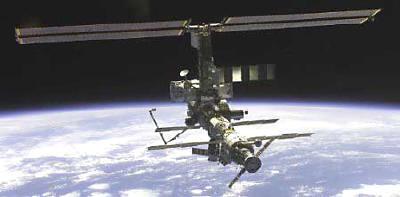Fri, Nov 14, 2003
4 p.m. CST, Friday, Nov. 7, 2003
The Expedition 8 crew
settled into life aboard the International Space Station this week,
squaring away their new home in orbit and beginning work with
several different experiments.
Commander and NASA ISS Science Officer Michael Foale and Flight
Engineer Alexander Kaleri began their week by making room inside
the habitable volume of the Station. After equalizing pressure with
the Destiny Laboratory, they opened Pressurized Mating Adapter 2
(PMA2) and stowed a variety of supplies and equipment that will not
be needed on short notice. They then closed the hatch to PMA2 and
depressurized the module.
Foale slipped on a specially instrumented glove as part of an
Italian scientific investigation into how hand and arm muscles are
used differently for reaching and grasping in microgravity. The
Hand Posture Analyzer also will attempt to quantify muscle fatigue
associated with long-duration space flight. Measurements taken with
a Posture Acquisition Glove on the hand, an Inertial Tracking
System on the wrist and Hand Grip and Pinch Force Dynamometers will
be compared with those taken before and after flight.
Foale and Kaleri also began taking either potassium citrate
pills or placebos and recording their food, water and medication
intake as part of the Renal (Kidney) Stone Risk During Spaceflight
experiment. Previous on-orbit experiments have shown an increased
risk in the development of kidney stones during and immediately
after space flight, and the experiment is testing a proven
Earth-based remedy in space.
Finally, Foale set up the Earth Knowledge Acquired by Middle
Schools digital camera in Destiny's optical-quality window so that
students in grades six through eight could take photos of the Earth
and downlink them for analysis by the student science team.
Meanwhile, Expedition 7 Commander Yuri Malenchenko and NASA ISS
Science Officer Ed Lu are at the Gagarin Cosmonaut Training Center
in Star City, Russia, continuing their immediate post-flight
medical evaluations and debriefings. They are expected to return to
Houston on Nov. 18. They landed on Oct. 27 after spending 183 days
aboard the Station. Joining them on the returning ISS Soyuz 6
spacecraft was European Space Agency astronaut Pedro Duque of
Spain, who conducted eight days of intensive research after
launching with the Expedition 8 crew.

More News
Terminal Radar Service Area Airspace surrounding designated airports wherein ATC provides radar vectoring, sequencing, and separation on a full-time basis for all IFR and participa>[...]
Aero Linx: Utah Back Country Pilots Association (UBCP) Through the sharing experiences, the UBCP has built upon a foundation of safe operating practices in some of the most challen>[...]
From 2010 (YouTube Edition): Imagine... Be The Change... Inspire FROM 2010: One of the more unusual phone calls I have ever received occurred a few years ago... from Anousheh Ansar>[...]
(Pilot) Felt A Shudder And Heard The Engine Sounding Differently, Followed By The Engine Chip Detector Light On April 14, 2025, about 1800 Pacific daylight time, a Bell 206B, N1667>[...]
Also: AMA Names Tyler Dobbs, More Falcon 9 Ops, Firefly Launch Unsuccessful, Autonomous F-16s The Air Force has begun ground testing a future uncrewed jet design in a milestone tow>[...]
 ANN's Daily Aero-Term (05.07.25): Terminal Radar Service Area
ANN's Daily Aero-Term (05.07.25): Terminal Radar Service Area ANN's Daily Aero-Linx (05.07.25)
ANN's Daily Aero-Linx (05.07.25) Classic Aero-TV: Anousheh Ansari -- The Woman Behind The Prize
Classic Aero-TV: Anousheh Ansari -- The Woman Behind The Prize NTSB Prelim: Bell 206B
NTSB Prelim: Bell 206B Airborne-NextGen 05.06.25: AF Uncrewed Fighters, Drones v Planes, Joby Crew Test
Airborne-NextGen 05.06.25: AF Uncrewed Fighters, Drones v Planes, Joby Crew Test



